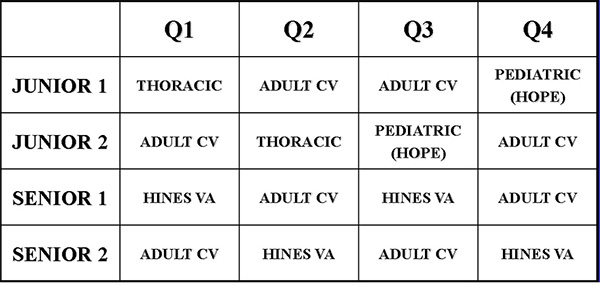Resident Rotations
Clinical Rotations of the Two-Year Categorical Training Program in Thoracic and Cardiovascular Surgery
The table below demonstrates the rotations for the two residents per clinical year of our two year program. While at Loyola, the two to three residents on the Thoracic and Adult Cardiovascular rotations have great flexibility in covering those cases they feel give them the greatest opportunity for education, while taking into account the benefits of longitudinal care.
While on the Thoracic rotation, the resident is understood to be primarily dedicated to that service, but if no outpatient or other clinical demand is concerned, he/she is free to scrub on any case. Beyond obligations to orient the junior residents at the beginning of the year, there is no hierarchy between years, though the order of the rotations has been organized to take maximum advantage of clinical progress in training. Therefore, by the time the junior residents rotate on the Congenital Cardiothoracic Service in the third or fourth quarters of the year, they have had a strong background in adult cardiothoracic practice to prepare them.
Similarly, the first year will prepare the resident to seize every opportunity for supervised autonomy at the Hines VA Hospital during the second year of residency, and to handle the most complex cases on Adult Cardiovascular and Thoracic services while at Loyola.
Our two year program has typically produced board eligible practitioners, ready to assume an independent clinical practice at the end of training: many have sought no further fellowship training. For those who want to obtain an advanced surgical credential through residency training in Congenital, or superfellowship in a specific discipline, the brevity of a two year program allows time saved compared to three year programs.

New Opportunities as of 2016: Elective Time and the Esophageal Service
At the request of the resident, a six-week portion or the entirety of one of the Loyola Adult CV blocks can be taken on the Loyola Thoracic Service during Q3 or Q4. While our program has always provided our graduates with the confidence to start work in Cardiovascular or Thoracic Surgery, we offer this elective time for the resident who plans on a primarily Thoracic career.
Elective time on Thoracic Surgery during the latter half of the year will smooth the transition from resident to attending for an individual who wishes to concentrate on this field, while allowing the first year resident exclusive access to that volume during the first two quarters of their first year.
Since January of 2016, in collaboration with Surgical Oncology at Loyola, the resident on the Thoracic Service takes charge of a new Esophageal Service, through which all esophageal malignancies are directed.
The patients are managed by the Thoracic Service resident in the Cardiothoracic Intensive Care Unit, under the supervision of the combined Thoracic Surgery/Surgical Oncology staff. Since January of 2016, residents of our program have counted 28 esophageal major cases.
